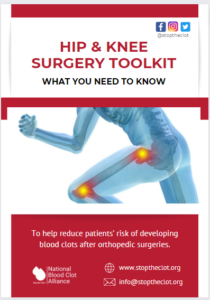Toolkit for Knee and Hip Replacement Patients
The Stop the Clot® Toolkit for Knee and Hip Replacement Patients aims to educate patients about the blood clot risks associated with these surgeries and empower them to take preventive measures. Knee or hip surgery is recognized as a significant risk factor for developing blood clots.
Joint Replacement Surgery and Blood Clot Facts
- Major surgery, such as joint replacement, can disrupt normal blood flow, leading to the formation of blood clots. These clots can result in the following medical conditions:
- Deep vein thrombosis (DVT): Occurs when a blood clot forms in deep veins, typically in the lower legs or groin.
- Pulmonary embolism (PE): Happens when a blood clot breaks loose and travels to the lungs, potentially blocking blood flow. PEs can be fatal. DVT is a well-recognized major risk for patients undergoing hip or knee replacement surgery.
- DVT and PE are frequently under-diagnosed but can be prevented and treated effectively if detected early.
- Without preventive treatment, up to 80 percent of orthopedic surgical patients may develop DVT, with 10 to 20 percent developing PE.
- Even with proper prevention measures, approximately 3 percent of orthopedic surgical patients may still develop DVT, and 1.5 percent may develop PE.
The Impact of DVT and PE
- DVT and subsequent PE are the leading causes of emergency room re-admission and death following joint replacement surgery. Approximately one-third (about 33 percent) of individuals who experience DVT/PE will encounter a recurrence within a decade.
- Over the long term, one-third of people who have had a DVT may suffer from lasting complications known as post-thrombotic syndrome. This condition can manifest as swelling, pain, discoloration, and scaling in the affected limb.
- An NBCA survey revealed that only 29 percent of hip replacement patients and 21 percent of knee replacement patients are familiar with DVT or PE. Alarmingly, nearly two-thirds of these patients did not receive additional information about the risks of blood clots associated with knee and hip replacement surgery from their healthcare professionals.
Risk Factors for DVT and PE Include:
High Risk
- Hospital stay
- Major surgery, such as abdominal/pelvic surgery
- Knee or hip replacement
- Major trauma
- Nursing home living
- Leg paralysis
Moderate Risk
- Older than 55
- Trips of more than four hours by plane, car, train, or bus
- Active cancer, chemotherapy
- Bone fracture or cast
- Estrogen-based birth control pills, patch, or ring
- Hormone therapy
- Pregnancy or childbirth
- Prior blood clot or family history of a clot
- Heart failure
- Bed rest for more than three days
- Obesity
- Genetic/hereditary or acquired blood clotting disorder
Signs and Symptoms of DVT and PE Include:
Deep Vein Thrombosis (DVT or blood clot in the leg or arm)
- Swelling, usually in one leg
- Leg pain or tenderness
- Reddish or bluish skin discoloration
- Leg warm to touch
These symptoms of a blood clot may feel like a pulled muscle or a charley horse but may differ in that the leg (or arm) may be swollen, slightly discolored, and warm.
Pulmonary Embolism (PE or blood clots in your lungs)
- Difficulty breathing
- Chest or back pain that worsens with a deep breath
- Coughing, or coughing up blood
PE can be fatal. If you experience any of these symptoms, call 9-1-1 or seek immediate medical attention.
Contact your doctor as soon as you can if you have these symptoms.
Prevention and Treatment of Blood Clots After Hip and Knee Replacement Surgery
Preventing and treating blood clots following hip and knee replacement surgery is a crucial aspect of your recovery. Joint replacement patients face the highest risk of developing DVT between two to 10 days after surgery and remain at risk for approximately three months.
To prevent blood clots, your doctor is likely to prescribe a combination of treatment approaches, including:
Anticoagulants
Anticoagulants, commonly referred to as blood thinners, play a critical role in preventing and treating blood clots. Your doctor will typically start you on anticoagulants the day after surgery, continuing throughout your hospital stay and into your at-home rehabilitation. The specific duration and type of medication prescribed will be determined by your physician. There are several types of anticoagulants:
- Direct Oral Anticoagulants (DOACs): These are the latest generation of anti-clotting medications available in pill form, taken orally once or twice daily, depending on the prescribed medication. Common DOACs include:
-
- Xarelto (rivaroxaban)
- Eliquis (apixaban)
- Pradaxa (dabigatran)
- Savaysa (Edoxaban)
- Heparin: Standard heparin and low molecular weight heparin are administered through subcutaneous injections. You may be taught to self-administer these injections or have a visiting nurse do it for you.
- Warfarin: In some cases, your doctor may prescribe warfarin instead of heparin or low molecular weight heparin for blood clot prevention. Warfarin is taken orally in pill form once daily.
It’s crucial to have a detailed discussion with your doctor to evaluate your treatment options, weigh their advantages and disadvantages, and consider potential side effects. Some of these medications may require strict adherence to a schedule, careful dietary management, and regular blood testing. For more specific information about each type of medicine visit this link.
Exercise and Physical Therapy
You will likely collaborate with a physical therapist to engage in targeted exercises aimed at regaining joint mobility, enhancing lower body strength, and promoting better circulation in your deep veins. In the case of knee replacement, your doctor might suggest the use of a continuous passive motion (CPM) machine, which gently facilitates knee movement.
Compression Stockings and Devices
Compression stockings come in graded designs, with tighter compression at the ankle that gradually decreases higher up the leg. Additionally, pneumatic or mechanical compression devices are available. The compression action enhances circulation and reduces the risk of blood clots by preventing the accumulation of blood in the veins.
Your doctor may prescribe compression stockings or offer guidance on purchasing them over the counter. Alternatively, your physician may recommend pneumatic compression devices that utilize air pumps to massage blood out of the lower leg and return it to the heart, similar to the effect of compression stockings. These devices can also help prevent blood clots by preventing blood from pooling in the legs.
During your recovery from joint replacement surgery, remain vigilant for potential blood clot symptoms, and promptly contact your physician if you experience any warning signs or symptoms.
Pre-Surgery Checklist for Hip and Knee Replacement Patients
This checklist can help you make the most of your time with your physician and gather information regarding the risk of blood clots associated with your surgery. If possible, consider bringing a family member or friend to the appointment to assist with notetaking and ensuring you fully understand the information provided.
Checklist
- What is my risk of developing blood clots after the surgery?
- Discuss any family history of blood clots with your physician.
- What is the plan to prevent blood clots post-surgery?
- Will I require compression stockings, and will they be provided?
- What type of post-surgery physical therapy is planned, including frequency (number of weekly sessions)? Should I contact the therapist before surgery to arrange this?
- Are there specific exercises I can do before surgery to strengthen my muscles?
- What type of anticoagulant medication do you intend to prescribe for me, and how long will I need to take it?
- What blood tests are necessary for this medication, and how often should I get tested? Can I perform these tests at home, or do I need to visit your office or a lab?
- What are the common side effects associated with this medication?
- Is it crucial to take this medication at the same time daily? Are there any medicines, herbs, or supplements that I should avoid while on this medication?
- Will I need to make dietary changes while on this medication? Are there specific foods I should include or avoid?
- What is the expected cost of this medication for me, and is it typically covered by insurance? (Note: You should also contact your insurance company directly to discuss your specific coverage.)
Here are some additional resources that may be helpful to you:
NBCA’s Stop the Clot® THA/TKA Patient Toolkit was made possible by an educational grant provided by Janssen Pharmaceuticals, Inc.





